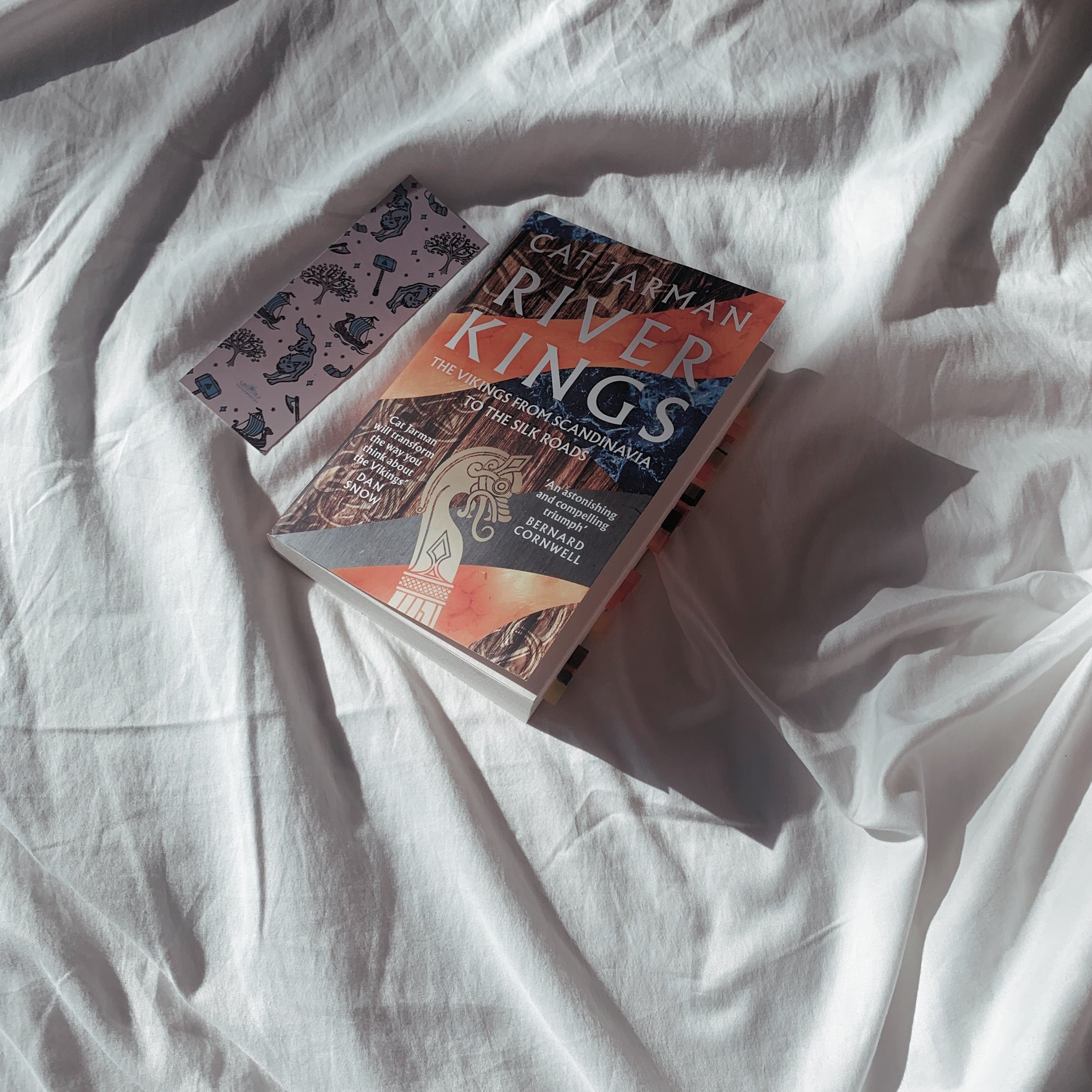★★★★☆ — thanks to Pegasus Books for providing me with the e-book of River Kings! In true Kelly fashion though, I did eventually go out and buy a paperback edition as well.
River Kings, written by bioarchaeologist Cat Jarman (who is also a field archaeologist who specialises in the Viking Period) takes a small carnelian bead found in the site of Repton and follows what may have been its journey through the Viking world all the way to Baghdad and India. Jarman works with DNA analysis, isotope analysis and radiocarbon dating of the archaeological finds to trace the Vikings from Britain, through Scandinavia and ultimately uncovers greater interaction and movement between the west and the east. Jarman uses these new scientific methods to gain new information from the bones and teeth of bodies we have known about for years, but now we can understand through the isotope analyses of bones and teeth where these people were born, their some of their migration history and even the type of diet they had. Using new scientific discoveries, archaeological evidence and the historical record (taking into account their bias and unreliability), Jarman starts in Repton, Darbyshire and follows the journey of a single carnelian bead through the world of the Vikings, using other objects as stepping stones to gain a new understanding of the movement and trade in the Viking world between Britain and as far as Gujarat, India, where the carnelian bead may have begun its journey.
At the beginning of each chapter, Jarman contextualises the object that will be the focus of the coming chapter in either a fictional or non-fictional way, imagining how it may have been used in the Viking world, or telling us of its modern history such as when it was discovered. It made me think of the structure of The Real Valkyrie which did something very similar at the beginning of each chapter! Early on, Jarman highlights issues she and other scholars and archaeologists face when interpreting evidence from the Viking world and doesn't hesitate to err on the side of caution when proposing solutions for issues in the book. Jarman introduced the old information, the new scientific information and even the biased and unreliable historical information and then proposes a tentative conclusion that gives the reader the opportunity to agree with her interpretation of the evidence, or to disagree. Her own personal experiences and insights really enriched the book, and gave weight to her suggestions and conclusions throughout the book.
The graves we find are multifaceted: we have no way of knowing whether those items even belonged to the deceased or whether they were gifts placed there by the mourners. They may not even reflect much about the person’s life… The dead do not bury themselves. (21)
…but unless you have another form of proof, it is practically impossible to prove the intention behind their death (38).
I am fascinated with the archaeology of death, and Jarman takes the time to highlight the issues surrounding interpretations of bodies, grave goods, identities and even the intention behind violent deaths and she does it succinctly, and early on in her book which really sets the tone for her interpretations and tentative conclusions later on. Jarman suggests caution when interpreting scientific evidence, and that we can only glean so much from the bones and the teeth about an individual. Honestly, it completely blew my mind, the things that we can learn from the different types of scientific dating and analysis.
Jarman dedicates much of her book to women in the Viking world and their place in the archaeological record, as well as slaves and their lack of representation in the record despite the lucrative slave trade we know was being conducted during this time. So much of this book fascinated me, and one of those things was how the early work at Repton overlooked women due to their skewed views on women at the time. Not to mention the dispute over the warrior woman found at Birka and the interesting discourse surrounding her. It has been questioned that just because she was buried with weapons does that make her a warrior in life, but these kinds of questions aren’t ever asked about men buried with weapons… Another topic of personal fascination is the discussion around how we cannot know the social significance and meaning of exotic goods in the Viking social context, and the recontextualising of material objects between different groups and cultures can transform their purpose and function. Were they a show of status and wealth? Did exotic goods show an individual’s power?
…genetics is not going to give us the ultimate answers: cultures and identities are far more complex and there is no such thing as a ‘genetic Viking.’ (128)
River Kings is like a stepping stone to even more answers about the Vikings, the objects they left behind and their, movement throughout their known world. As more testing is conducted and new evidence is found, more and more will be understood about the Vikings, and this book is like the first piece of the puzzle on the journey to understanding the whole picture. Not only does Jarman work to understand how a single carnelian bead ended up in a Viking burial at Repton, but she stresses the importance of our understanding of how these types of objects fit into the wider Viking world. This book is a truly rich insight into the trade and movements of people, beliefs and objects in the Viking world, and I could not recommend it enough to any lover of archaeology, ancient trading and the Vikings.
Have you read River Kings? What did you think of it? Do you have any book recommendations for lovers of Vikings? Let me know in the comments of this post, or over on my Instagram @kell_read ✨


